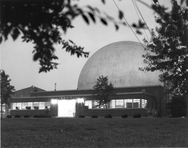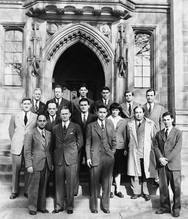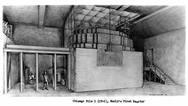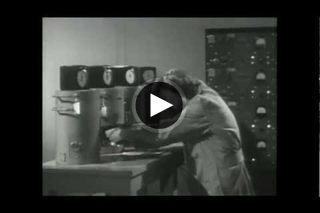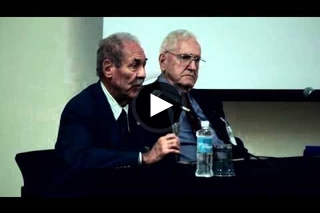Argonne marks 70th anniversary of first man-made nuclear chain reaction
By Louise Lerner • December 2, 2012Seventy years ago today on Dec. 2, 1942, World War II was raging overseas, and Enrico Fermi and 48 other scientists gathered in a squash court beneath the football stadium at the University of Chicago. They were about to witness the first self-sustaining nuclear chain reaction—soon to be a revolutionary new source of energy.
They stood before the reactor, named Chicago Pile 1: a massive tower of graphite, uranium and wooden support frames weighing more than 400 tons. Six men stood ready with three separate safety systems at hand. As the control rods went in, uranium atoms embedded within the reactor began to split apart. The loose neutrons shot off and split open other atoms. Fermi ticked off the measurements, calmly predicting each development. At 3:53 p.m., 28 minutes into the experiment, he declared the reaction was sustaining itself. The Nuclear Age was underway.
After the war, Fermi moved the laboratory west of Chicago, where it was renamed Argonne National Laboratory and charged with building nuclear reactors for peaceful energy generation. Almost every reactor around the world today is based on research done at Argonne.
Fermi and the supporting scientists were building on work that had begun decades earlier as physicists chewed over the question of what the universe is made of. Scientists had known for a long time that protons and electrons existed, but the missing piece wasn’t discovered until the 1930s: the neutron. The neutron is what allows us to get energy from nuclear reactions. On the way to puzzling out the secrets of the universe, scientists had discovered a way to power our houses and appliances without releasing carbon into the atmosphere.
Nearly nine years to the day after the first reaction, Argonne’s Experimental Breeder Reactor-I lit a string of four light bulbs to become the world’s first reactor to produce a useful amount of electricity. That reactor was a type called a fast reactor, cooled by liquid sodium. Today’s commercial reactors are a different type called thermal reactors, cooled by water. Future reactor designs, however, are mostly fast reactors, since this type of reactor uses uranium much more efficiently and can recycle spent nuclear fuel.
Argonne built 28 reactors at its two sites to study everything from basic physics to actual working small-scale prototypes, including a prototype called the Experimental Boiling Water Reactor, which was later scaled up to full-size as a commercial reactor in nearby Dresden, Ill. Thanks partially to its location as the birthplace of nuclear energy, the Chicagoland area still gets more than 85 percent of its electricity from nuclear power.
Argonne celebrated Chicago Pile 1's 70th anniversary with a symposium featuring visits from two nuclear pioneers: Harold Agnew, former director of Los Alamos National Laboratory and one of the 49 scientists present at Stagg Field, and Len Koch, one of Argonne’s earliest staff members and a designer of Experimental Breeder Reactor-I. The symposium was moderated by former Argonne associate laboratory director Charles Till, who led Argonne’s nuclear engineering programs for decades and oversaw the development of the Integral Fast Reactor. The scientists recounted working with Fermi and other scientific giants in the promising new world of atomic energy.
Argonne continues to study nuclear energy, though it no longer has operational reactors on its campus. Today’s research focuses on making nuclear energy safer, cleaner, cheaper and even smaller. Supercomputers often aid in designing new reactor types and materials. With more than 400 reactors operating around the world, nuclear power is the largest source of carbon-free electricity in the world today.
After Fermi’s declaration that December afternoon, the scientists at the squash court shared a Chianti toast from paper cups. They all signed the empty bottle, and then they went back to work.


